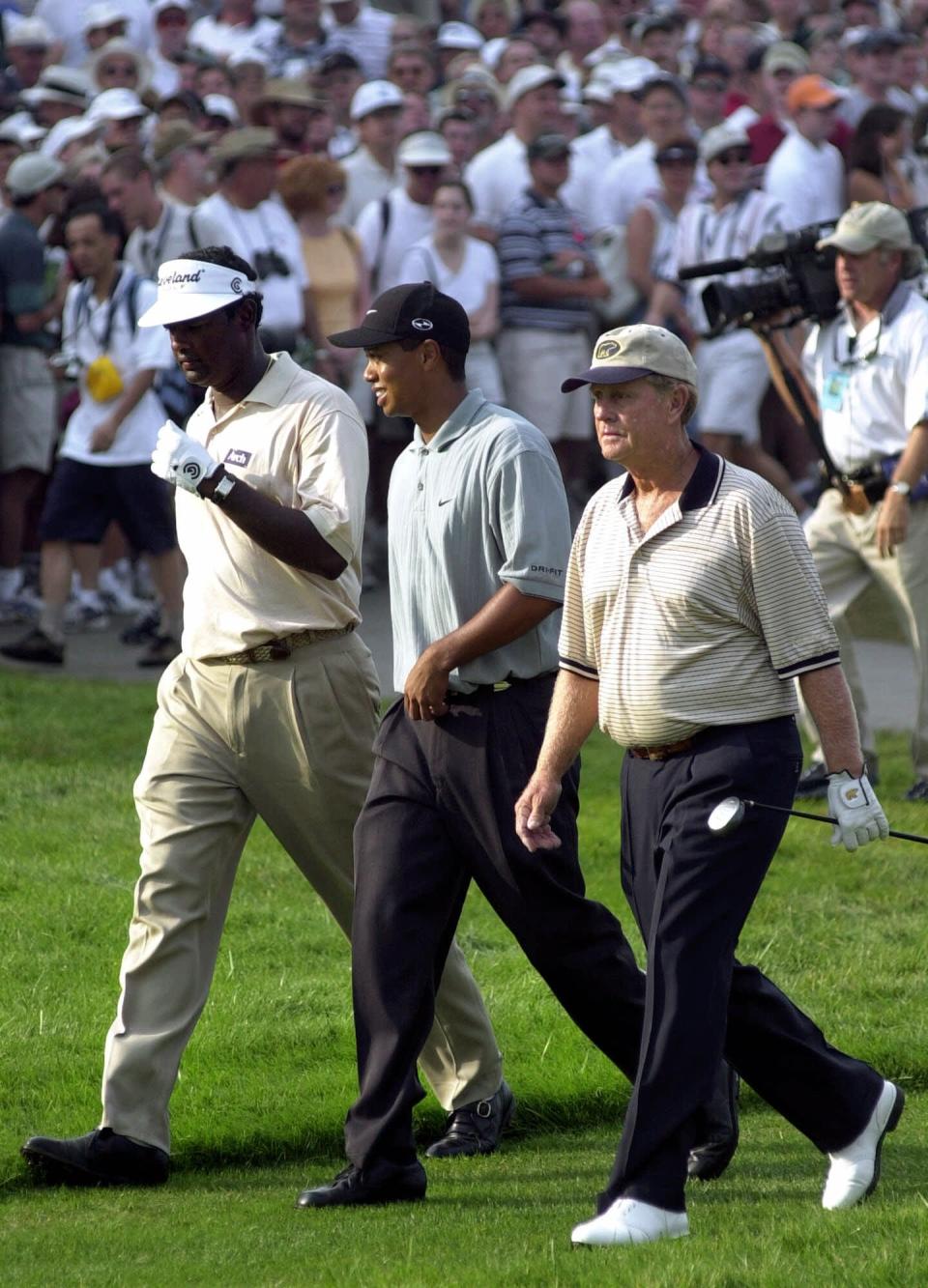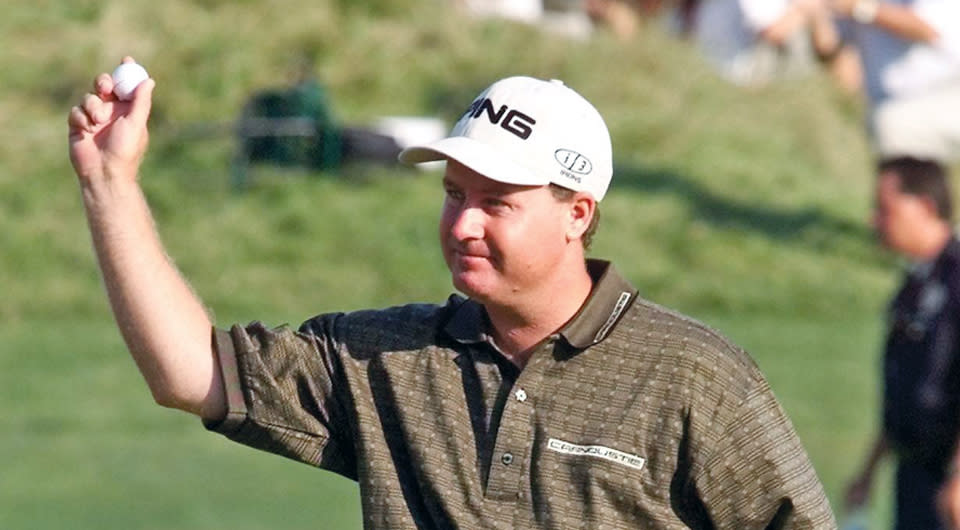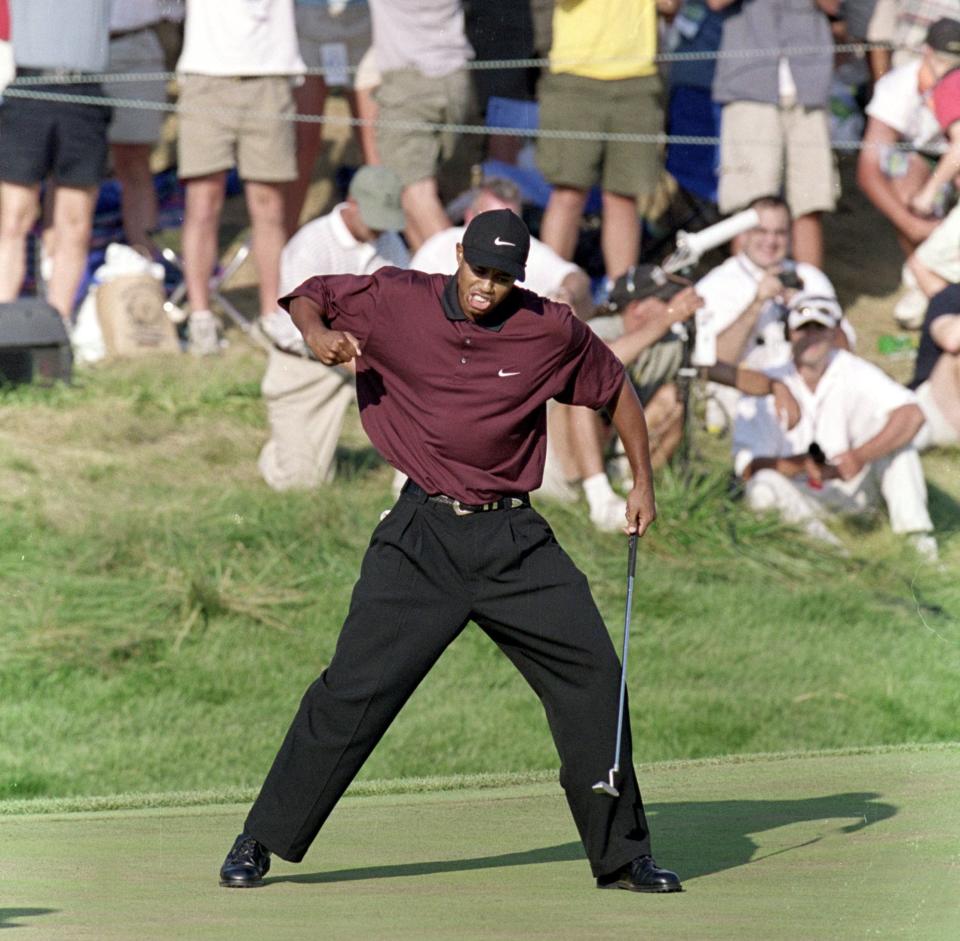Louisville Sluggers: Bob May, Tiger Woods traded blows in epic PGA Championship at Valhalla in 2000

It’s so easy now, with more than two decades of hindsight, for all the victories to converge into one uninterrupted stretch of dominance. The Tiger Woods of 1999 and 2000 won 17 PGA Tour events in his early 20s and suddenly, explosively, was the dominant force in golf.
He had fully burst into the spotlight with his eye-popping performance at the 1997 Masters, shattering the scoring record with the most dominant display in major championship history. After a relatively quiet year in 1998 in which he reworked his swing, he stared down a young Sergio Garcia to win his second major title at the 1999 PGA Championship at Medinah Country Club in Illinois.
Entering the 2000 PGA Championship at Valhalla Golf Club in Louisville, Kentucky, Woods was without doubt the star, capable of shotmaking and power and putting prowess unmatched by his older peers.
Spoiler alert: Woods won that PGA Championship, part of the greatest streak in golf history. But that 2000 PGA Championship was special, because Woods was pushed to an extent he rarely experienced during the peak of his powers. Almost every great shot he hit was matched in the final round, and for once, the ultimate frontrunner had a running mate down the line at Valhalla.
Tiger Woods and Bob May duel at Valhalla
👉@MichaelRMason @rgoodson21 @timothygreenman @bogeyj33 pic.twitter.com/suG6kaDxFj
— PGA Championship (@PGAChampionship) March 26, 2020
Woods had started the year on a heater, winning early-season Tour events in Hawaii, California, Florida and Ohio. And he was just getting warmed up.
Woods blew away the field at the 2000 U.S. Open in June at Pebble Beach, notching a 15-shot win for the largest victory margin ever in a major. He then claimed his fourth major title and second in a row at the Open Championship in July at the Old Course at St. Andrews, this one by a mere eight shots. He had claimed three titles in a stretch of four major championships, and he had locked up the career Grand Slam before his 24th birthday.
If it seemed as if Woods couldn’t lose, it was because he wasn’t doing much losing. He headed into the PGA Championship as the strong favorite at Valhalla Golf Club, and he had exposed this fact to all who dared challenge him. Tiger was the man to beat, and nobody seemed able to do it.
Enter Bob May
Nobody wants to be called a journeyman, but that description perfectly fit May, then a 31-year-old who had split time between the PGA Tour and the European Tour. He had never won on the PGA Tour, but his impressive junior-golf record in California had once been a target for a younger Woods. At the start of the PGA Championship at Valhalla, May had climbed to No. 48 in the world.
As the Championship progressed into Sunday’s final round, May vs. Woods had all the makings of a classic David-vs.-Goliath matchup that nobody saw coming. It’s easy to look back now and say the outcome seemed predetermined based on Woods’ sterling record as a closer, but that would be a case of hindsight being 20/20 because May was determined to take it to Woods.
And Woods, coming into Valhalla on an 18-month hot streak, looked entirely human for a spell in the third round and again early in the fourth.
Valhalla’s course was designed by Jack Nicklaus with major aspirations, having first hosted the 1996 PGA Championship won by Mark Brooks in a playoff over Kentucky native Kenny Perry. The layout featured thick bluegrass rough and tricky Nicklaus greens, many of which included several tiers.
Jack’s swan song
By the 2000 PGA Championship, the 60-year-old Nicklaus was nearing the end of his major championship career. The course he built in Kentucky would be the last he would play in the PGA Championship. But there was one more reason to watch the Golden Bear. He was paired with Woods in the first two rounds, Vijay Singh occupying the third spot in their group.

Vijay Singh, Tiger Woods and Jack Nicklaus walk from the first tee during the first round of the 2000 PGA Championship at Valhalla Golf Cub in Louisville.
It was the first time Nicklaus and Woods played competitive rounds together.
Woods wasted no time showing off in front of the man whose records he was chasing, shooting 6-under-par 66 to share the first-round lead with Scott Dunlap. A second-round 67 gave Woods the outright lead by one over Dunlap, who was playing some of the best golf of his life.
By and large, Woods did it by manhandling Valhalla’s four par 5s. With length to spare, Woods was 7 under par on those holes after playing each of them twice, seven birdies in eight attempts.
“I knew that he was good, but I had never played with him in a tournament before,” Nicklaus, who missed the cut by a shot, said during a televised interview after the first two rounds. “And he is so much better than I thought he was. It just absolutely amazed me. It was a unique experience for me to play with him the last two days.”
May, meanwhile, didn’t get off to the greatest start. By then a Las Vegas resident, May was an incredible longshot after opening with an even-par 72. A talented iron player, he climbed into the fringes of contention with a bogey-free 66 in the second round, but he was five shots behind Woods on a packed leaderboard.
Nobody could have predicted what would come
In Saturday’s third round, May racked up seven birdies in a 10-hole stretch and hung a second consecutive 66 on the board. Woods, meanwhile, started struggling a touch with his putter — nothing too alarming, but not every putt was dropping as some fans had come to expect. He was still dominating the par 5s in general, but a double bogey on the par-4 12th included a missed 3 footer.
Woods hung tough for a 2-under 70 and a one-shot lead over May, who was one shot clear of Dunlap and JP Hayes. But, unexpectedly, there appeared to be gaps in Woods’ armor.
Sunday turned into one of the greatest two-man duels in major championship history. Woods and May, paired together in the final group, distanced themselves from the field. And despite many expectations, it was May who started hot.
Woods struggled early with two bogeys in the first six holes, including a three-putt on a par 5. Meanwhile, May flipped the script with birdies on two of the first four holes. He bogeyed the sixth, but as the pairing walked to No. 7 tee, the journeyman had a two-shot lead and appeared fearless, throwing great iron shot after great iron shot at a Woods who couldn’t seem to dodge the blows. David had Goliath on the ropes.

Bob May at the 2000 PGA Championship.
But No. 7 is a par 5, and Woods did what he does on such holes, making birdie to cut May’s lead to one. Woods then reheated his putter with a 12-footer that found the cup on No. 8 to reach 13 under par and square what soon would become a two-man match. The contestants took a breather with pars on No. 9 before heading to the back nine.
After the turn, they threw birdies at each other hole after hole. May had three birdies in a row on Nos. 10-12 to take a 1-up lead despite Woods birdieing Nos. 10 and 12. They both birdied the long par-3 14th, May again knocking his approach inside Woods’ before each rolled in a putt. May again struck a beautiful approach on 15, but this time he misread his birdie putt and settled for par after Woods had made a 15-footer for his par, later calling that save a deciding point of the tournament.
Woods stuck a wedge approach tight on 17 to pull even with May as they lapped the rest of the field, and with the title on the line each man reached the par-5 18th green in two shots. Neither eagle putt came close, with May actually running his off the green and onto the fringe before Woods missed by 5 feet.
By this point, each player had four birdies on that back nine, and with everything on the line in regulation, neither backed down on 18. May knocked in his long birdie putt from the fringe, fist-pumping on his way to retrieve the ball from the hole. Woods then rolled his shorter putt home to tie May at 18 under par at the end of regulation, generating a Woods fist-pump of his own.
Each man shot 5-under 31 on that back nine, no bogeys between them. Woods had to birdie seven of the final 12 holes to catch the underdog May: No player had pushed Woods to those extremes in any of his previous major victories.
A playoff first at the PGA
They set off for a three-hole aggregate playoff, the first time that format was employed in the PGA Championship, replacing the previous sudden-death method. And Woods struck early.
May drove left into tall rough on Valhalla’s 16th, and his second shot found more rough short and right of the green. From there, an exceptional pitch-and-run trundled across the green, up to the back tier and to within a few inches to secure a par.
But Woods, having found the fairway with a 2-iron tee shot and having hit the green with his approach, rolled in a 25-footer for birdie. And it wasn’t just that Woods made the putt. He followed the ball toward the hole, quick-stepping as it approached the cup and pointing as it tumbled in, giving the cameras one of his most iconic reactions. His birdie drew the first and only blood of the playoff.
Both men struggled on No. 17, May getting up and down from a greenside bunker while Woods was forced to pitch out of the trees with his second, bouncing his ball off a cart path and over the green before scrambling for a par to maintain his one-shot playoff lead.
Then came one of the luckiest breaks of Woods’ career. On the third and final hole of the playoff, he badly tugged his drive toward trees and bushes. After a few tense seconds in which nobody seemed to know where the ball was, it could be seen on the television coverage rebounding down a cart path to a much better location, albeit still in light rough.

Tiger Woods celebrates making a birdie putt on the 18th hole to force a playoff at the 2000 PGA Championship at Valhalla Golf Club in Louisville, Kentucky. (Photo: Donald Miralle/Allsport)
There has been speculation that Woods’ ball was either kicked or thrown by a fan, but there’s no solid evidence to promote such a claim. If his ball had remained in the thickest trouble, his one-shot lead would have been in peril.
May also pulled his drive into the rough, and both men missed the fairway with their ensuing layups on the par 5. Woods then found the front bunker with his third shot, while May blasted his approach from deep grass onto the green within 25 feet of the hole. This thing wasn’t over yet, as a make by May or a bad bunker shot by Woods could yet square the playoff.
Woods then did what he does, blasting from the sand to within 18 inches to guarantee his par. May needed to sink that 25-footer for birdie, and for most of its length it appeared as if he might have done it. But the putt broke hard near the end and missed by inches, and Woods had his third major victory in a row.
“Anytime you get to play against the best, and be able to come out on top against the best, it’s always going to be more satisfying,” Woods said after the round. “The last two years the PGA Championship has drawn the best field, and I’ve been very fortunate to be able to win. But to be able to tee it up and go toe-to-toe against the best players in the world, that’s what you dream about.”
May had come within a whisker of knocking the wind out of Woods, ultimately falling one shot shy of victory in regulation and then losing by just one shot in the playoff.
“I wanted to concentrate real hard out there today and, you know, prove to people I can play out here,” May said in a post-round television interview. “It’s not a question anymore. I went out and played a good solid round of golf, and was just one shot too short.”
The two players’ careers diverged greatly after that PGA Championship before suffering similar infirmities.
Woods kept winning, racking up a total nine PGA Tour victories in 2000. He added the Masters title in 2001, giving him all four major trophies in a row. Call it a non-calendar- year Grand Slam if you like or not, but there’s no denying it was the greatest professional major streak in the history of the game.
May kept swinging well in the weeks after the PGA Championship, finishing third at the Reno-Tahoe Open the next week and adding three more top-20 finishes on Tour that year. Over the next several seasons, he continued on Tour before hurting his back in 2003, the spinal injury eventually leading to surgery. After more than a year away from golf, he returned to play a handful of more seasons before more pain led to a second surgery. After turning 50 in 2018, he tried to qualify for the PGA Tour Champions but has played only a handful of events. Much of his focus has shifted to the eponymous golf academy he operates in Las Vegas.
Woods, meanwhile, went on to arguably the best career in professional golf history with 15 major titles and 82 PGA Tour victories before suffering a series of injuries himself, including his own back problems that led to multiple surgeries.
All these years after his stunning showdown with May in Louisville, Woods is also trying to prepare his body for PGA Tour starts.
The two players were on divergent paths that eventually led to similar pain and limited play. But for that week at Valhalla, each was in his prime, and they put on one of the greatest shows the game has ever seen.

